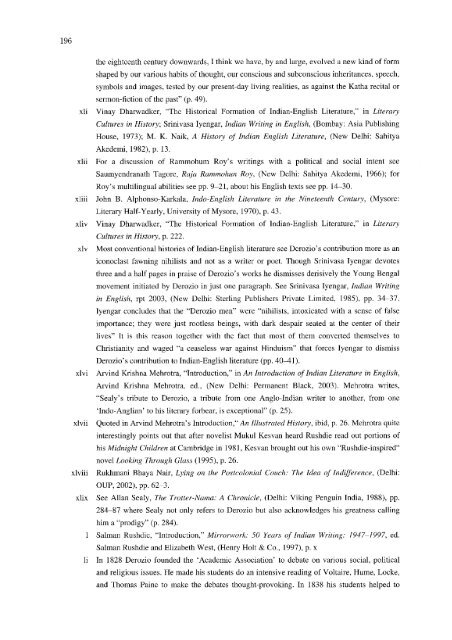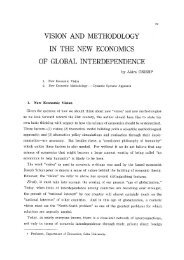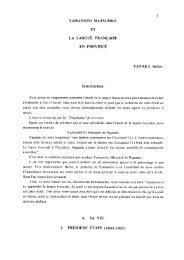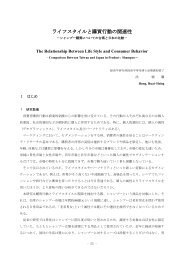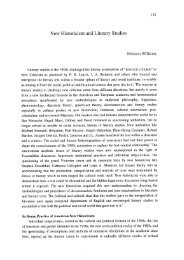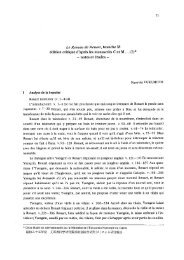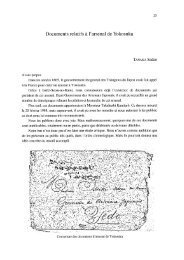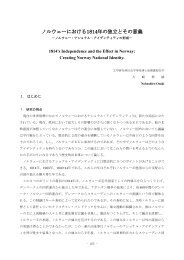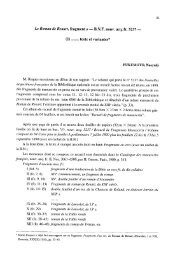Indian Writing in English 1794-2004 - Soka University Repository
Indian Writing in English 1794-2004 - Soka University Repository
Indian Writing in English 1794-2004 - Soka University Repository
You also want an ePaper? Increase the reach of your titles
YUMPU automatically turns print PDFs into web optimized ePapers that Google loves.
196<br />
the eighteenth century downwards, I th<strong>in</strong>k we have, by and large, evolved a new k<strong>in</strong>d of form<br />
shaped by our various habits of thought, our conscious and subconscious <strong>in</strong>heritances, speech,<br />
symbols and images, tested by our present-day liv<strong>in</strong>g realities, as aga<strong>in</strong>st the Katha recital or<br />
sermon-fiction of the past" (p. 49).<br />
xli V<strong>in</strong>ay Dharwadker, "The Historical Formation of <strong>Indian</strong>-<strong>English</strong> Literature," <strong>in</strong> Literary<br />
Cultures <strong>in</strong> History; Sr<strong>in</strong>ivasa Iyengar, <strong>Indian</strong> <strong>Writ<strong>in</strong>g</strong> <strong>in</strong> <strong>English</strong>, (Bombay: Asia Publish<strong>in</strong>g<br />
House, 1973); M. K. Naik, A History of <strong>Indian</strong> <strong>English</strong> Literature, (New Delhi: Sahitya<br />
Akedemi, 1982), p. 13.<br />
xlii For a discussion of Rammohum Roy's writ<strong>in</strong>gs with a political and social <strong>in</strong>tent see<br />
Saumyendranath Tagore, Raja Rammohun Roy, (New Delhi: Sahitya Akedemi, 1966); for<br />
Roy's multil<strong>in</strong>gual abilities see pp. 9-21, about his <strong>English</strong> texts see pp. 14-30.<br />
xliii John B. Alphonso-Karkala, Indo-<strong>English</strong> Literature <strong>in</strong> the N<strong>in</strong>eteenth Century, (Mysore:<br />
Literary Half-Yearly, <strong>University</strong> of Mysore, 1970), p. 43.<br />
xliv V<strong>in</strong>ay Dharwadker, "The Historical Formation of <strong>Indian</strong>-<strong>English</strong> Literature," <strong>in</strong> Literary<br />
Cultures <strong>in</strong> History, p. 222.<br />
xlv Most conventional histories of <strong>Indian</strong>-<strong>English</strong> literature see Derozio's contribution more as an<br />
iconoclast fawn<strong>in</strong>g nihilists and not as a writer or poet. Though Sr<strong>in</strong>ivasa Iyengar devotes<br />
three and a half pages <strong>in</strong> praise of Derozio's works he dismisses derisively the Young Bengal<br />
movement <strong>in</strong>itiated by Derozio <strong>in</strong> just one paragraph. See Sr<strong>in</strong>ivasa Iyengar, <strong>Indian</strong> <strong>Writ<strong>in</strong>g</strong><br />
<strong>in</strong> <strong>English</strong>, rpt 2003, (New Delhi: Sterl<strong>in</strong>g Publishers Private Limited, 1985), pp. 34-37.<br />
Iyengar concludes that the "Derozio men" were "nihilists, <strong>in</strong>toxicated with a sense of false<br />
importance; they were just rootless be<strong>in</strong>gs, with dark despair seated at the center of their<br />
lives" It is this reason together with the fact that most of them converted themselves to<br />
Christianity and waged "a ceaseless war aga<strong>in</strong>st H<strong>in</strong>duism" that forces Iyengar to dismiss<br />
Derozio's contribution to <strong>Indian</strong>-<strong>English</strong> literature (pp. 40-41).<br />
xlvi Arv<strong>in</strong>d Krishna Mehrotra, "Introduction," <strong>in</strong> An Introduction of <strong>Indian</strong> Literature <strong>in</strong> <strong>English</strong>,<br />
Arv<strong>in</strong>d Krishna Mehrotra, ed., (New Delhi: Permanent Black, 2003). Mehrotra writes,<br />
"Sealy's tribute to Derozio , a tribute from one Anglo-<strong>Indian</strong> writer to another, from one<br />
`Indo -Anglian' to his literary forbear , is exceptional" (p. 25).<br />
xlvii Quoted <strong>in</strong> Arv<strong>in</strong>d Mehrotra's Introduction," An Illustrated History, ibid, p. 26. Mehrotra quite<br />
<strong>in</strong>terest<strong>in</strong>gly po<strong>in</strong>ts out that after novelist Mukul Kesvan heard Rushdie read out portions of<br />
his Midnight Children at Cambridge <strong>in</strong> 1981, Kesvan brought out his own "Rushdie-<strong>in</strong>spired"<br />
novel Look<strong>in</strong>g Through Glass (1995), p. 26.<br />
xlviii Rukhmani Bhaya Nair, Ly<strong>in</strong>g on the Postcolonial Couch: The Idea of Indifference, (Delhi:<br />
OUP, 2002), pp. 62-3.<br />
xlix See Allan Sealy, The Trotter-Nama: A Chronicle, (Delhi: Vik<strong>in</strong>g Pengu<strong>in</strong> India, 1988), pp.<br />
284-87 where Sealy not only refers to Derozio but also acknowledges his greatness call<strong>in</strong>g<br />
him a "prodigy" (p. 284).<br />
1 Salman Rushdie, "Introduction," Mirrorwork: 50 Years of <strong>Indian</strong> <strong>Writ<strong>in</strong>g</strong>: 1947-1997, ed.<br />
Salman Rushdie and Elizabeth West, (Henry Holt & Co., 1997), p. x<br />
li In 1828 Derozio founded the 'Academic Association' to debate on various social, political<br />
and religious issues. He made his students do an <strong>in</strong>tensive read<strong>in</strong>g of Voltaire, Hume, Locke,<br />
and Thomas Pa<strong>in</strong>e to make the debates thought-provok<strong>in</strong>g. In 1838 his students helped to


